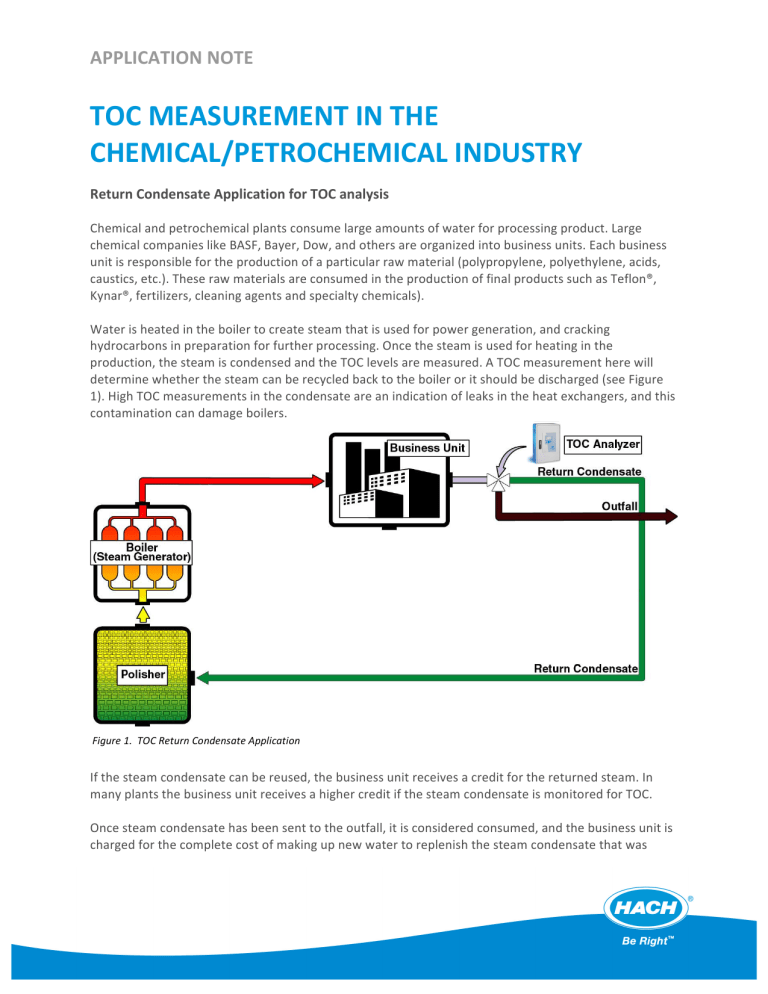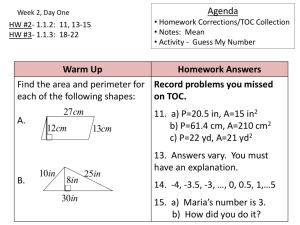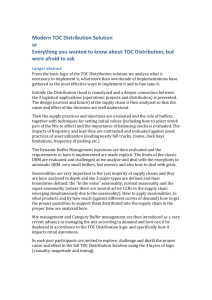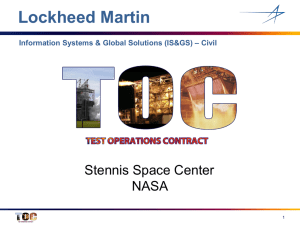L2143_TOC Monitoring in the Chemical and Petrochemical

APPLICATION NOTE
TOC MEASUREMENT IN THE
CHEMICAL/PETROCHEMICAL INDUSTRY
Return Condensate Application for TOC analysis
Chemical and petrochemical plants consume large amounts of water for processing product. Large chemical companies like BASF, Bayer, Dow, and others are organized into business units. Each business unit is responsible for the production of a particular raw material (polypropylene, polyethylene, acids,
caustics, etc.). These raw materials are consumed in the production of final products such as Teflon®,
Kynar®, fertilizers, cleaning agents and specialty chemicals).
Water is heated in the boiler to create steam that is used for power generation, and cracking hydrocarbons in preparation for further processing. Once the steam is used for heating in the production, the steam is condensed and the TOC levels are measured. A TOC measurement here will determine whether the steam can be recycled back to the boiler or it should be discharged (see Figure
1). High TOC measurements in the condensate are an indication of leaks in the heat exchangers, and this contamination can damage boilers.
Figure 1. TOC Return Condensate Application
If the steam condensate can be reused, the business unit receives a credit for the returned steam. In many plants the business unit receives a higher credit if the steam condensate is monitored for TOC.
Once steam condensate has been sent to the outfall, it is considered consumed, and the business unit is charged for the complete cost of making up new water to replenish the steam condensate that was
contaminated. The business units are individually responsible for their own productivity and efficiency based in part on steam consumption. A central steam plant feeds all of the business units at a particular site, and charges the business units according to their usage. Measuring TOC not only makes the use/reuse decision automatic, it provides a gauge for the amount of cleanup that will be necessary.
To be repolished, the steam must be cooled or condensed into water and it must be relatively clean; therefore this application requires low–level monitoring. We recommend a Hach BioTector B3500C in the range of 0–10 mg/l, 0-‐25 mg/l, 0–50 mg/l or 0–100 mg/l, typically installed between the condenser
and the return condensate pipe in a temperature-‐controlled analyzer shelter or in the utilities building.
Storm Water Application for TOC Analyzer
Chemical and petrochemical plants are surrounded by storm water ditches. These ditches are designed to contain storm water run off during rain conditions or a major spill. Typically storm water run off is permitted for discharge into a body of water untreated, however because of the nature of chemical and petrochemical processes the storm water may have a high content of organic contaminants. When the
TOC measurement is higher than the permitted level, it is diverted into a retention (holding) tank to be slowly released into the wastewater treatment plant. When the TOC measurement is lower than the permitted value, it is discharged untreated.
Figure 2. TOC Storm Water Application
For example, at a chemical plant, a Hach BioTector B7000 is being used to measure the Total Organic
Carbon of the storm water run off. The customer chose the B7000 TOC analyzer because the oxidation method allows it to handle high concentrations of hard to oxidize organic products in the sample and high salt content. In this application, no filters were installed because the patented oxidation method used by the B7000 can handle particles up to 2 mm in size. The B7000 is also available with a self-‐ cleaning option that cleans the sample path in the instrument after every measurement. This self-‐ cleaning technology allows for maximum up time with minimal service requirements (6-‐month service intervals). During a storm event a level switch (rain gauge) will actuate a pump to draw sample from the
storm water ditch to the analyzer. (see Figure 2).
Business Unit, Combined Outfall, and Final Effluent Applications for TOC Analysis
Because each business unit is judged on its own profitability, process water from each business unit and sometimes each individual stream is monitored for TOC. This assures that the business unit is charged
fairly for the clean up. This measurement is typically performed by a Hach BioTector B7000 TOC analyzer. The analyzer is installed in the water line between the business unit and the waste stream.
(see Figure 3).
Without a TOC measurement at each unit outfall, a combined outfall TOC measurement is taken and all the business units divide the cost of clean up evenly. Then the combined outfall is sent to the wastewater treatment plant for treatment. The Final Effluent is monitored for TOC and will have to meet the discharge permit limits before being discharged into a body of water.
Figure 3. TOC Applications for Business Unit Outfall, Combined Outfall, and Final Effluent
Summary of Applications
As you can see, petrochemical and chemical plants have many applications for TOC monitoring. (see
Figure 4). With the Hach BioTector family of analyzers, these plants can improve process efficiency and avoid costly issues. Hach BioTector B7000 TOC analyzers are designed for samples with high salt content
(>300 ppm), oils, greases, difficult to oxidize compounds, or samples with high concentrations of solids.
The B7000 is typically the analyzer of choice for wastewater influent and effluent monitoring as well as business unit outfall applications. Hach BioTector B3500c condensate analyzers are designed for clean industrial applications such as return condensate. Reach out to your local Hach representative for assistance in configuring the most reliable and accurate TOC analyzer for your applications.
Figure 4. Summary of TOC Chemical and Petrochemical Applications
FOR TECHNICAL ASSISTANCE, PRICE INFORMATION AND ORDERING:
Tel: 800-‐227-‐4224 | E-‐Mail: techhelp@hach.com
To locate the HACH office or distributor serving you, visit: www.hach.com
LIT2143
© Hach Company, 2014. All rights reserved.
In the interest of improving and updating its equipment, Hach Company reserves the right to alter specifications to equipment at any time.






